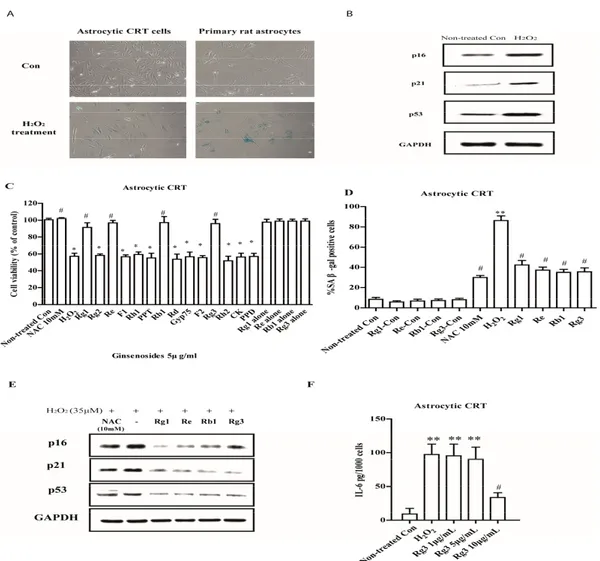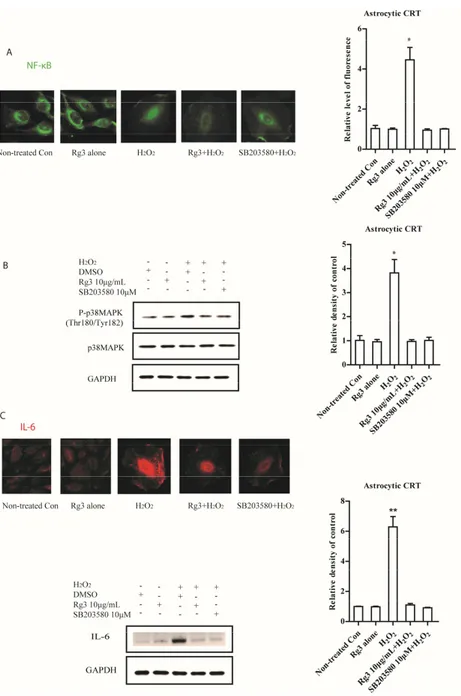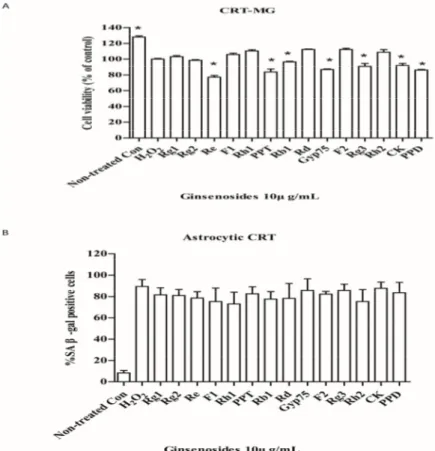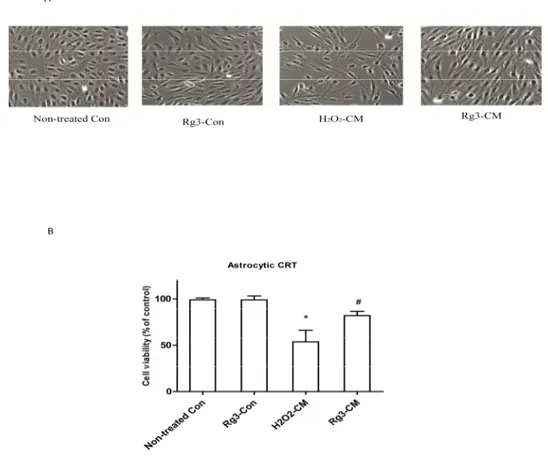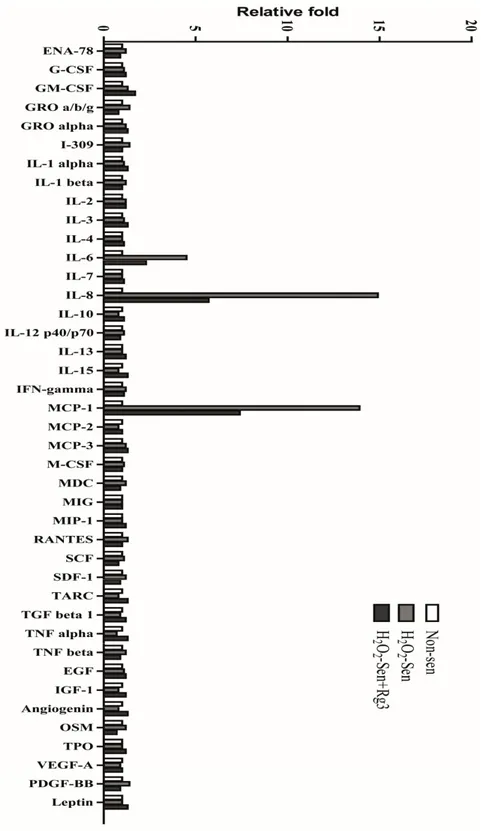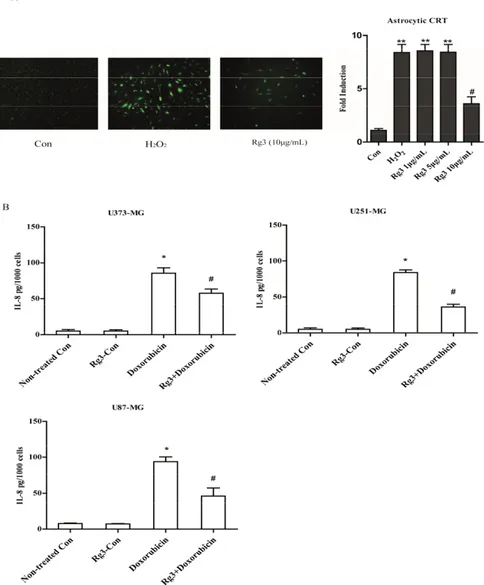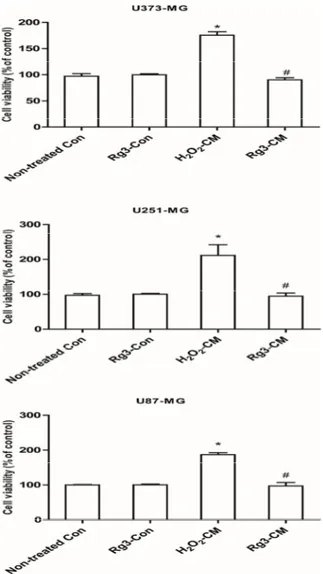molecules
ArticleGinsenoside Rg3 Prevents Oxidative Stress-Induced
Astrocytic Senescence and Ameliorates Senescence
Paracrine E
ffects on Glioblastoma
Jingang Hou1, Sunchang Kim1,2,*, Changkeun Sung3and Chulhee Choi4 1 Intelligent Synthetic Biology Center, Daejeon 34141, Korea; houjingang1225@126.com
2 Department of Biological Sciences, Korea Advanced Institute of Science and Technology (KAIST), Daejeon 34141, Korea
3 Department of Food Science and Technology, College of Agriculture and Biotechnology, Chungnam National University, Daejeon 34141, Korea; kchsung@kaist.ac.kr
4 Department of Bio and Brain Engineering, Korea Advanced Institute of Science and Technology (KAIST), Daejeon 34141, Korea; cchoi@kaist.ac.kr
* Correspondence: sunkim@kaist.ac.kr; Tel.:+82-042-350-2619
Received: 1 August 2017; Accepted: 8 September 2017; Published: 10 September 2017
Abstract: Senescent astrocytes in aging brain express senescence-associated secretory phenotype (SASP) and link with increased brain aging and its related diseases. In order to determine whether ginsenosides ameliorate the astrocytic senescence in vitro, human astrocytic CRT cells and primary rat astrocytes were used in the present study. Ginsenosides Rg1, Re, Rb1 and Rg3 (5 µg/mL) could effectively prevent the astrocytic senescence induced by H2O2exposure. However, these ginsenosides
did not reverse the astrocytic senescence. Importantly, senescent astrocytes herein produce SASP. The expression of major components of SASP, IL-6 and IL-8, are greatly increased in senescent astrocytes. Ginsenoside Rg3 (10 µg/mL) effectively suppressed the expressions of IL-6 and IL-8, which is associated with regulations of NF-κB and p38MAPK activation. In addition, after incubation with Rg3, conditioned medium from senescent astrocytic CRT cells significantly decreased the ability to promote the proliferation of astrocytoma U373-MG, U87-MG and U251-MG cells compared with non-treated senescent samples. Similar patterns were confirmed in chemotherapy-induced glioblastoma senescent cells. The present study explored a potential candidate for amelioration of astrocytic senescence and SASP in brain aging, which provided a basis for developing strategies to reduce the dark side of senescence in normal or pathological aging process.
Keywords: astrocytic senescence; ginsenosides; SASP; brain tumor; inflammation
1. Introduction
Aging is characterized by a progressive loss of physiological function, giving rise to tissue dysfunction and increased vulnerability to diseases and death. The hallmarks of aging are summarized to identify pharmaceutical targets and improve human healthy lifespan. One of the these hallmarks is cellular senescence, which have a complex phenotype characterized by irreversible cell-cycle arrest mediated predominated by p16ink4aand p21, increased cellular size, altered morphology, resistance to apoptosis, and a unique secretory phenotype referred as senescent-associated secretory phenotype (SASP) [1]. Although researches on the causes and mechanisms underlying the various types of cellular senescence are still in its infancy, telomere erosion, DNA lesion and reactive oxidation species (ROS) have been shown to induce cellular senescence [2–5]. The damaging ROS known to be responsible for neurotoxicity are hydrogen peroxide (H2O2), superoxide anions (O2−) and hydroxyl radicals (OH).
H2O2is the major precursor of ROS that may result in cellular damage and its excessive accumulation
Molecules 2017, 22, 1516 2 of 14
is observed during brain aging and neurodegenerative diseases [6]. Hence H2O2is an available stress
inducer for researches on cellular senescence and the aging brain.
Astrocytes play a fundamental role on the maintenance of homeostasis of the central nervous system (CNS) as well as defense [7]. Aging brain affects many functional characteristics that are
regulated by astrocytes. Increased expression of glial fibrillary acidic protein indicates human astrocyte senescence, which also implies this astrocytic senescence represses their enhancement on neurogenesis and neuronal protection [8,9]. In aging rat brain, expression of cytokines, such as TNF-α, IL-1β and IL-6 were localized in astrocytes, suggesting astrocytes express a proinflammatory phenotype during aging [10]. In culture systems, astrocytes initiate senescence progress in response to oxidative stress, proteasome inhibition and exhausted replication. Prominent increased senescence markers were observed and it also implies that astrocytes are more susceptible than fibroblast in response to oxidative stress [11]. Additionally, depletion of glutathione could trigger inflammatory pathway and increase secretion of IL-6, demonstrating a neurotoxicity of secretory astrocytic phenotype in relevant to aging and degenerative neurological disease [12]. Extended culture of astrocytes associates with increased expression of senescence markers and loses the neuroprotective capacity [13]. Interestingly, β-amyloid peptide also stimulates chemokine expression, the secretion of ROS and cytokines from rat astrocytes [14]. All of above observations indicate that at least in vitro astrocytes are capable of triggering senescence phenotype and the astrocytes in aged brain display the characteristic typical for inflammatory SASP.
In oriental medicine, ginseng is able to strengthen vital energy in different body locations to delay aging. Interestingly, ginseng are also viewed as adaptogenic herbs, giving that they increase body’s resistance to various stresses, trauma, anxiety and fatigue. Ginsenosides, the metabolites of ginseng, are attributable to the pharmacological and biological activities of ginseng used as medicinal plants in traditional oriental medicine [15]. Unsurprisingly, a large number of researches encompassed anti-aging of ginsenosides emerges every year. Especially, the beneficial effects of ginsenosides on aging related pathologies, such as Alzheimer Disease, Parkinson disease and Huntington’s Diseases are reported [16–18]. Hence, the non-specific and multi-targets properties of ginsenosides are proposed as typical characteristics of anti-aging herbal ginseng.
In the present study, we used oxidative stress stimulated by H2O2to induce astrocytic senescence.
Our results demonstrate that Rg3 is able to prevent astrocytic senescence, and further ameliorate the side effects of SASP on brain pathology.
2. Results
2.1. Selected Ginsenosides Prevent Astrocytic Senescence and Decrease SASP
To establish the cellular senescence in response to oxidative stress in human astrocytes, 35 µM and 150 µM of H2O2were used to treat CRT astrocytic cells and primary rat astrocytes respectively for 2 h,
then the medium were replaced and cultured for 72 h. The results showed that H2O2treatment induced
the expressions of SA β-gal and resulted in morphologic changes in CRT cells and primary rat astrocytes. The cultures displayed enlarged, flatten morphology typical of senescence, and entered a growth arrest (Figure1A). These observed changes were accompanied by increased expression of p16, p21 and p53, three biomarkers of senescence (Figure1B). To test the possibility that ginsenosides could regulate astrocytic senescence, astrocytic cells were exposed to 14 different ginsenosides. Selected ginsenosides Rg1, Re, Rb1 and Rg3 with 5 µg/mL pretreatment for 12 h significantly decreased cell growth inhibition (Figure1C) and SA β-gal expression (Figure1D) in CRT astrocytic cells. These selected ginsenosides also suppressed the expressions of p16, p21 and p53 in H2O2treated CRT cells (Figure1E).
To determine whether selected ginsenosides decrease the expressions of IL-6, the major SASP component in human cells, we measured the extracellular expression of IL-6 using ELISA assay. Interestingly, newly selected ginsenoside Rg3 decreased the secretion of IL-6 when added after the SASP fully developed (8 d after H2O2induced senescence; Figure1F).
Molecules 2017, 22, 1516 3 of 14
Molecules 2017, 22, 1516; doi:10.3390/molecules22091516 www.mdpi.com/journal/molecules
Article
Ginsenoside Rg3 Prevents Oxidative Stress‐induced
Astrocytic Senescence and Ameliorates Senescence
Paracrine Effects on Glioblastoma
Figure 1. Ginsenosides prevent astrocytic senescence and decrease SASP induced by H2O2. (A)
Senescent astrocytic cells and primary rat astrocytes induced by H2O2 express SA‐β‐gal under light
microscopy. (B) Proteins were extracted from control and H2O2 treated astrocytic CRT cells and
analyzed by western blotting for senescent markers p16, p21 and p53. GAPDH as a loading control. (C) Astrocytic CRT cells were pretreated with 5 μg/mL of ginsenosides for 12 h, followed by 2 h treatment with 35 μM of H2O2, and then cell proliferation was assayed after 72 h by WST‐1. * p < 0.05
versus H2O2‐treated group. (D) The percentage of SA‐β‐gal positive cells in astrocytic cells after
treated by indicated groups. 10 μM of NAC was used as positive control. (E) Protein levels of senescence markers p16, p21 and p53 in astrocytic CRT cells of “D”. GAPDH as a loading control. (F) Major components SASP, IL‐6 quantified using ELISA. * p < 0.05, ** p < 0.01, groups versus Non‐ treated Con; # p < 0.05, groups versus H2O2. Five samples corresponding to each indicated ginsenoside
group were evaluated for cell viability and galactosidase staining. Three samples corresponding to each concentration were counted.
Figure 1. Ginsenosides prevent astrocytic senescence and decrease SASP induced by H2O2. (A) Senescent astrocytic cells and primary rat astrocytes induced by H2O2express SA-β-gal under light microscopy. (B) Proteins were extracted from control and H2O2treated astrocytic CRT cells and analyzed by western blotting for senescent markers p16, p21 and p53. GAPDH as a loading control. (C) Astrocytic CRT cells were pretreated with 5 µg/mL of ginsenosides for 12 h, followed by 2 h treatment with 35 µM of H2O2, and then cell proliferation was assayed after 72 h by WST-1. * p< 0.05 versus H2O2-treated group. (D) The percentage of SA-β-gal positive cells in astrocytic cells after treated by indicated groups. 10 µM of NAC was used as positive control. (E) Protein levels of senescence markers p16, p21 and p53 in astrocytic CRT cells of “D”. GAPDH as a loading control. (F) Major components SASP, IL-6 quantified using ELISA. * p< 0.05, ** p < 0.01, groups versus Non-treated Con;#p< 0.05, groups versus H2O2. Five samples corresponding to each indicated ginsenoside group were evaluated for cell viability and galactosidase staining. Three samples corresponding to each concentration were counted.
2.2. Ginsenoside Rg3 Decreases SASP by Suppressing NF-κB Nuclear Translocation and p-38 Activation As NF-κB stimulates the transcription of many SASP genes [19], we tested the possibility that selected ginsenosides decreased NF-κB activity. In addition, p-38 mitogen-activated protein kinase (p38MAPK), a mediator of SASP in response to various stimuli [20], were also measured. Intriguingly, we measured the nuclear translocation of NF-κB by immunocytochemistry staining. Selected ginsenoside Rg3 reduced NF-κB nuclear translocation (Figure2A). Similarly, activation of p38MAPK significantly increased during senescence process, nevertheless, selected ginsenoside Rg3
Molecules 2017, 22, 1516 4 of 14
suppressed this activation in senescent astrocytic CRT cells (Figure2B). Furthermore, we found that this suppression on p38MAPK greatly abolished the expression of IL-6 (Figure2C).
Molecules 2017, 22, 1516 2 of 7
Figure 2. Senescent astrocytic CRT cells develop SASP by activating NF‐κB nuclear translocation and
p38MAPK activity. (A) Immunofluorescence with NF‐κB in senescent astrocytic CRT cells. H2O2 (35
μM) treatment after 8 d induced flatten morphological changes and profound NF‐κB nuclear translocation. Ginsenoside Rg3 (10 μg/mL) treatment significantly decreased this translocation. (B) Western blots showing the total and phosphorylated p38 MAPK in H2O2 (35 μM) treated senescent
astrocytic CRT cells. 10 μM SB203520 as a positive control. GAPDH as a loading control. (C) The expressions of IL‐6 were abolished in the presence of SB203580 or Rg3 in senescent astrocytic CRT cells. * p < 0.05, ** p < 0.01, groups versus Non‐treated Con.
Figure 2.Senescent astrocytic CRT cells develop SASP by activating NF-κB nuclear translocation and p38MAPK activity. (A) Immunofluorescence with NF-κB in senescent astrocytic CRT cells. H2O2(35 µM) treatment after 8 d induced flatten morphological changes and profound NF-κB nuclear translocation. Ginsenoside Rg3 (10 µg/mL) treatment significantly decreased this translocation. (B) Western blots showing the total and phosphorylated p38 MAPK in H2O2(35 µM) treated senescent astrocytic CRT cells. 10 µM SB203520 as a positive control. GAPDH as a loading control. (C) The expressions of IL-6 were abolished in the presence of SB203580 or Rg3 in senescent astrocytic CRT cells. * p< 0.05, ** p< 0.01, groups versus Non-treated Con.
2.3. Selected Ginsenosides Do Not Reverse Cellular Senescence
In the senescent human astrocytic CRT cells (4 d after senescence induction), post-treatment of ginsenosides did not reverse the cell growth arrest induced by H2O2(Figure3A), nor did it decrease
Molecules 2017, 22, 1516 5 of 14
In addition, ginsenosides seemed to selectively induce cell death. We proposed that certain ginsenosides are potential senolytic agents for senescent astrocytes induced by H2O2. Although selected ginsenoside
greatly decreased the expressions of IL-6 which are reported to be responsible for senescence growth arrest, it does not reverse this arrest. We presume that other factors derived from SASP are attributed to this phenomenon. Further tests are needed to prove it.
Molecules 2017, 22, 1516 3 of 7
Figure 3. Ginsenosides do not reverse astrocytic senescence. (A) Senescent astrocytic CRT cells were
treated with 10 μg/mL of ginsenosides for 24 h, then cell viability was assayed by WST‐1. Cell death was observed after treatment. * p < 0.05 versus H2O2 group. (B) The percentage of cells expressing SA‐
β‐gal was determined by light microscopy and counting. Five samples corresponding to each indicated ginsenoside group were evaluated for cell viability and galactosidase staining.
Figure 3.Ginsenosides do not reverse astrocytic senescence. (A) Senescent astrocytic CRT cells were treated with 10 µg/mL of ginsenosides for 24 h, then cell viability was assayed by WST-1. Cell death was observed after treatment. * p< 0.05 versus H2O2group. (B) The percentage of cells expressing SA-β-gal was determined by light microscopy and counting. Five samples corresponding to each indicated ginsenoside group were evaluated for cell viability and galactosidase staining.
2.4. Ginsenoside Rg3 Decreases the Ability of Senescent Astrocytes to Inhibit Normal Cell Growth
The main SASP components, IL-6 can reinforce the cell growth arrest in oncogene-induced senescent cells [21]. As can be remarkably seen in Figure4, conditioned medium reduced cell growth of normal astrocytic CRT cell by 50%. However, conditioned medium from ginsenoside Rg3 group significantly rescued the cell growth up to 27%. Interestingly, Rg3 treatment did not rescue the morphological changes induced by conditioned medium.
Molecules 2017, 22, 1516 6 of 14
Molecules 2017, 22, 1516 4 of 7
Figure 4. Ginsenoside Rg3 suppresses cell growth arrest by conditioned medium from senescent
astrocytic CRT cells. (A) Conditioned medium (CM) inhibited the growth of astrocytic CRT cells after 48 h treatment. Cells treated with conditioned medium showed enlarged, flattened, and irregular shape. The morphological changes were observed under light microcopy. (B) Cell proliferations were determined by WST‐1. * p < 0.05, Non‐treated Con versus H2O2‐CM; # p < 0.05, ginsenoside Rg3‐CM
versus H2O2‐CM. Five samples corresponding to each indicated ginsenoside group were evaluated
for cell viability.
Figure 4. Ginsenoside Rg3 suppresses cell growth arrest by conditioned medium from senescent astrocytic CRT cells. (A) Conditioned medium (CM) inhibited the growth of astrocytic CRT cells after 48 h treatment. Cells treated with conditioned medium showed enlarged, flattened, and irregular shape. The morphological changes were observed under light microcopy. (B) Cell proliferations were determined by WST-1. * p< 0.05, Non-treated Con versus H2O2-CM;#p< 0.05, ginsenoside Rg3-CM versus H2O2-CM. Five samples corresponding to each indicated ginsenoside group were evaluated for cell viability.
2.5. Oxidative Stress-Induced Astrocytic Senescence Secrets High Level of IL-8
In order to determine whether senescent astrocytic cells secrete other SASP components, the conditioned medium by antibody array test was examined. Intriguingly, we found that IL-8 and MCP-1 were secreted substantially in senescent astrocytic CRT cells. Importantly, Rg3 could suppress the IL-8 and MCP-1 secretion, which is similar to the suppression of IL-6 secretion (Figure5).
To test whether Rg3 regulates IL-8 expression at transcriptional level, astrocytic CRT cells were stably transfected with construct IL-8p-d2EGFP, which is a destabilized enhanced green fluorescent protein (EGFP)-expressing plasmid under the control of the IL-8 promoter. The cells were induced to senescence as indicated in method section. As a result, 7.1 fold increase by H2O2was observed
compared with control group. Additionally, Rg3 (10 µg/mL) reduced the IL-8 EGFP reporter activity by 2.6 fold compared with control group (Figure6A).
To confirm if Rg3 could selectively suppress the expression of IL-8 in oxidative stress-induced SASP, we measured the IL-8 secretion in senescent glioblastoma cells induced by chemotherapy agent Doxorubicin. Notably, Rg3 significantly decreased IL-8 secretions in U373-MG, U251-MG and U87-MG cell lines (Figure6B).
Molecules 2017, 22, 1516 7 of 14
Molecules 2017, 22, 1516 5 of 7
Figure 5. Ginsenoside Rg3 suppresses the secretion of major components from SASP. Conditioned
medium from non‐senescent or senescent cells treated with or without Rg3 were collected and
analyzed by antibody array.
Figure 5. Ginsenoside Rg3 suppresses the secretion of major components from SASP. Conditioned medium from non-senescent or senescent cells treated with or without Rg3 were collected and analyzed by antibody array.
Molecules 2017, 22, 1516 8 of 14
Molecules 2017, 22, 1516
6 of 7
Figure 6. Oxidative stress induced astrocytic senescence and secreted high level of IL‐8. (A) The
transcriptional level of IL‐8 was evaluated by reporter constructed CRT (IL‐8p‐d2EGFP) cells. (B)
Doxorubicin (100 nM) treatment for 72 h induced astrocytic senescence and secretion of IL‐8. * p <
0.05, Non‐treated Con versus Doxorubicin‐CM;
#p < 0.05, ginsenoside Rg3‐CM versus Doxorubicin‐
CM. Five samples corresponding to each indicated ginsenoside group were evaluated for cell viability
and galactosidase staining. Three samples corresponding to each concentration were counted.
Figure 6. Oxidative stress induced astrocytic senescence and secreted high level of IL-8. (A) The transcriptional level of IL-8 was evaluated by reporter constructed CRT (IL-8p-d2EGFP) cells. (B) Doxorubicin (100 nM) treatment for 72 h induced astrocytic senescence and secretion of IL-8. * p< 0.05, Non-treated Con versus Doxorubicin-CM;#p< 0.05, ginsenoside Rg3-CM versus Doxorubicin-CM. Five samples corresponding to each indicated ginsenoside group were evaluated for cell viability and galactosidase staining. Three samples corresponding to each concentration were counted.
2.6. Ginsenoside Rg3 Decreases Paracrine Effects of Senescent Astrocytic Cells on Glioblastomas
SASPs were able to stimulate cell proliferation and tumorigenesis, hence we determined the effects of SASP from senescent astrocytes on glioblastomas. Unsurprisingly, all the three glioblastoma cell lines (U373-MG, U87-MG and U251-MG) showed essential increased proliferation. Rg3 greatly reduced the stimulation of proliferation effect of conditioned medium from senescent astrocytic CRT cells (Figure7). Additionally, Rg3 alone treatment did not differ from non-treated group.
Molecules 2017, 22, 1516 9 of 14 Molecules 2017, 22, 1516 7 of 7 Figure 7. Conditioned medium promotes the cellular proliferation of major glioblastoma cell lines. The indicated glioblastoma cells U87‐MG, U373‐MG and U251‐MG were incubated with conditioned medium for 48 h. Cell proliferations were determined by WST‐1. * p < 0.05, group versus Non‐treated control; # p < 0.05, ginsenoside Rg3‐CM versus H2O2‐CM. Five samples corresponding to each
indicated ginsenoside group were evaluated for cell viability.
Figure 7.Conditioned medium promotes the cellular proliferation of major glioblastoma cell lines. The indicated glioblastoma cells U87-MG, U373-MG and U251-MG were incubated with conditioned medium for 48 h. Cell proliferations were determined by WST-1. * p< 0.05, group versus Non-treated control;#p< 0.05, ginsenoside Rg3-CM versus H2O2-CM. Five samples corresponding to each indicated ginsenoside group were evaluated for cell viability.
3. Discussion
Our results confirmed that oxidative stress induces astrocytic senescence and possible brain tumorigenesis process that involves SASP. Emerging evidences indicate that cellular senescence accumulates in tissues with aging, which confers tissue degeneration and dysfunction [22,23]. The SASP that implies chronic inflammation in brain may be partly explained by senescent astrocytes. Our findings show that some selected ginsenosides (Rg1, Re, Rb1 and Rg3) can prevent the astrocytic senescence induction by oxidative stress, however, these ginsenosides do not reverse senescence. It is possible, therefore, that manipulations on SASP by potential ginsenosides may provide a new strategy to abrogate the deleterious effects of astrocytic senescent in brain. Intriguingly, one anticipated finding was that ginsenoside Rg3 inhibits expressions of IL-6 and IL-8, major components of SASP, by inactivating NF-κB and p38MAPK activity. This finding was unexpected because NF-κB and p38MAPK activations have been extensively investigated and reviewed in senescence, and suggests the potential mechanism of Rg3 on regulating astrocytic SASP.
Additionally, glioblastoma, a kind of aggressive and fatal brain tumor increases with age [24]. IL-6 secretion in response to external stimuli or intrinsic factors, such as IL-1β or TNF-α, was reported
Molecules 2017, 22, 1516 10 of 14
previously [25]. Furthermore, IL-6-induced activation of STAT3 have been wildly reported to promote invasion and migration in U251-MG and U87-MG glioblastoma cells [26]. Importantly, IL-6 derived from cerebral cells, strongly inhibits apoptosis of glioblastoma cell invasion and plays a pivotal role in maintain glioblastoma stem cell properties [27]. Additionally, IL-8 is highly expressed in glioblastoma cell lines and linked to malignant cell proliferation and tumor growth [28]. More importantly, patients received surgical removal of GBM commonly take a long-term radiation and chemotherapy treatment. It is reported that long-term radiation induces upregulation of IL-6 and IL-8 in tumor cells [29] and treatment with temozolomide increases production of inflammatory mediators in brain [30]. In the present study, our results further confirmed inhibition of IL-6 and IL-8 secretion of conditioned media from senescent astrocytic CRT cells could abrogate the stimulation of astrocytoma cell lines (U373-MG, U87-MG and U251-MG). This abolishing action was also available in chemotherapy induced glioblastoma cellular senescence. Hence these findings are significant in at least two major respects: (1) SASPs form senescent astrocytes secrete IL-6 and IL-8 (2) IL-6 and IL-8 promote proliferation of glioblastoma. This combination of findings provides some support for the conceptual premise that cellular senescence may be potential target for curing aging-related pathologies in brain.
Ginsenoside Rg3 is widely known as a clinical anticancer therapy and enriched in ginseng products, such as red ginseng and black ginseng [31]. Recent studies also suggest that ginsenoside Rg3 greatly sensitizes cancer cells when combined with conventional chemotherapeutic agents [32,33]. Moreover, chemotherapy is reported to induce senescence and this promotes side effect in tissue and even cancer relapse [34]. Our results herein suggest another possibility, at least in vitro human astrocyte models: Ginsenoside Rg3 may decrease inflammation caused by senescent astrocytic cells and the SASP. In addition, it is worthy that ginsenoside Rg3 has been implicated to induce cancer cell death [35], as well as protection of normal cells (astrocytes) from senescence.
Although ginsenoside Rg3 has been extensively reported to exert anticancer pharmacological activities [36,37], it barely targeted brain tumors both in vivo and in vitro [38]. The ultimate limitation of Rg3 on brain tumor might be attributed to the poor blood brain barrier permeability. Thus, efficient delivery methods are needed with regard to target brain tumor and senescent brain cells. Exosomes, secreted nanoparticles, are important mediators of intercellular communication and proposed as drug delivery vehicles [39]. Therapeutic cargos (such as, siRNA, peptide, doxorubicin and curcumin) are loaded into exosomes to target various diseases [40–43]. This possible source of delivery system could be a carrier for ginsenoside Rg3 to reach the area of disease.
Here, our findings suggest that selected ginsenosides Rg1, Re, Rb1 and Rg3 partly prevent the senescence and Rg3 greatly suppresses the major components of SASP, IL-6 and IL-8. Therefore, ginsenoside Rg3 might be a candidate for the amelioration of senescence and its inflammatory or paracrine side effects during aging process. This may help us to understand how ginsenosides may suppress aging and its related pathologies, including late-life cancer process. Importantly, ginsenoside Rg3 may provide a candidate for declining the dark side of senescence derived from normal or chemotherapy-induced aging process.
4. Materials and Methods
4.1. Cells and Culture Conditions
CRT-MG and U373-MG cells were maintained in RPMI 1640 medium (Hyclone, South Logan, UT, USA) with 10% heat-inactivated fetal bovine serum (FBS, G), 100 U of penicillin/mL, and 100 µg of streptomycin/mL (Thermo Fisher Scientific Korea Ltd., Seoul, Korea) as previously described [44]. U251-MG and U87-MG cells were grown in Dulbecco’s Modified Eagle Medium (DMEM, Hyclone, South Logan, UT, USA) supplemented with 10% heat-inactivated fetal bovine serum (FBS), 100 U of penicillin/mL, and 100 µg of streptomycin/mL. Primary rat and human astrocytes were maintained in 10% FBS-DMEM containing 1% nonessential amino acids (Thermo Fisher Scientific Korea Ltd., Seoul, Korea). Stable cell line CRT-MG/IL-8p-d2EGFP cells were prepared and maintained as previously
Molecules 2017, 22, 1516 11 of 14
described [45]. Briefly, stable reporter cell lines transfected with the human IL-8 promoter-luciferase reporter construct were generated. Then the construct and a destabilized enhanced green fluorescent protein (EGFP)-expressing plasmid, pd2EGFP (Clontech, Mountain View, CA, USA), were digested by using XhoI and BamHI (Clontech, Mountain View, CA, USA). The pd2EGFP backbone and the 546-bp insert containing the IL-8 promoter were ligated to generate IL-8p-d2EGFP.
4.2. Reagents
Ginsenosides Rg1, Re, F1, Rh1, Rh1, PPT, Rb1, Rd, Gyp75, F2, Rg3, Rh2, CK and PPD, with a purity of more than 98%, were all prepared with High Performance Liquid Chromatography (HPLC) (Tokyo, Japan). Each ginsenoside was dissolved in dimethyl sulfoxide (DMSO) as 10 mg/mL solution. N-acetyl cysteine (NAC) and hydrogen peroxide (H2O2) were purchased from Sigma (St. Louis, MO, USA).
4.3. Senescence Induction
Induction of astrocytes senescence by H2O2was performed as previously described [11], CRT-MG
cells and primary rat astrocytes were incubated for 2 h in medium containing 35 and 150 µM H2O2
(determined by preliminary tests) respectively, then washed and cultured by fresh complete medium for 3 d.
4.4. SA-β-Gal Staining
Senescence-associated β-galactosidase (SA-β-gal) staining was performed using a SA-β-gal kit (#9860, Cell Signaling Technology, Inc., Beverly, MA, USA) in accordance with the manufacturer’s protocol. The cells were fixed for 10–15 min at room temperature, then rinsed twice with PBS and stained with staining solution at a final pH of 6.0 for at least overnight. The SA-β-gal positive cells develop blue color and were counted under a phase-contrast microscope. The experiment was repeated three times in each group.
4.5. Preparation of Conditioned Medium (CM), Antibody Array Test and Quantification of IL-6 and IL-8 Secretion
CRT-MG cells were exposed by H2O2(35 µM) to induce premature secretory senescence. Eight days
following senescence induction, fresh medium containing ginsenoside Rg3 or SB203580 or DMSO were added and cultured for 24 h. Then replaced by serum-free and collected from both pre-senescent and senescent cells after 48 h. CM were centrifuged for 20 min at 5000 rpm, and filtered through 0.22 µm bottle-top filters (Sartorius Stedim Biotech, Göttingen, Germany). The collected medium were applied to antibody array (Ray Biotech, Cat#AAH-CYT-5-2, Norcross, GA, USA). IL-6 and IL-8 levels in conditioned media were quantified using Human IL-6 and IL-8 ELISA RayBiotech protocol (Cat# ELH-IL-6-1, Norcross, GA, USA)
4.6. Cell Viability Assay
Cell viability was evaluated by the WST-1 assay (Abcam, Cambridge, MA, USA), which is based on the enzymatic cleavage of the tetrazolium salt WST-1 to formazan by cellular mitochondrial dehydrogenase present in viable cells. In brief, after 24 h treatment, 20 µL of WST-1 was added to each well and the plates were incubated at 37◦C for 2 h. The plates were then centrifuged and 100 µL of the medium was withdrawn for measuring the absorbance value at a wavelength of 450 nm using microplate reader.
4.7. Immunoblotting
To assay the expression of p16ink4a, p53, p21, total cellular proteins were extracted using M-PER
mammalian protein extraction reagent (Thermo Fisher Scientific Korea Ltd., Seoul, Korea). Briefly, cells grown in 60 mm petri dishes were washed three times with 5 mL cold PBS. A volume of 200 µL
Molecules 2017, 22, 1516 12 of 14
of extraction reagent was added to each plate. The cells were then dislodged by scraping and were transferred to Eppendorf tubes. The protein concentrations were estimated and equalized. The cell lysate was loaded in each lane and separated by SDS-PAGE. Proteins were electrophoretically transferred to nitro-cellulose membrane and non-specific sites were blocked by 3% of Bovine Serum Albumin (BSA). Protein expression was detected using a primary antibody p16ink4a, p53, p21 (1:2000 Abcam, Cambridge, MA, USA), GAPDH (1:4000, Santa Cruz, Dallas, TX, USA) and horseradish peroxidase-conjugated anti-rabbit and anti-mouse secondary antibodies (1:5000, Santa Cruz, Dallas, TX, USA). Quantitative analysis of Western blot was performed using Image J software (Windows version of NIH Image,
http://rsb.info.nih.gov/nih-image/, USA). The protein of GAPDH was used as the loading control. For immunofluorescence assay, the cells were first rinsed twice with PBS, followed by fixation with 4% (wt/vol) paraformaldehyde for 20 min. Cells were blocked in assay diluent containing 3% (wt/vol) BSA and 0.15% TritonX-100 in PBS solution. Cells were then incubated with primary antibody against NF-κBp65 (rabbit polyclonal, Santa Cruz, Dallas, TX, USA 1:200), IL-6 (mouse monoclonal, Abcam, 1:1000) overnight at 4◦C. After repeated rinses with PBS solution, cells were incubated with appropriate Alexa fluorogenic secondary antibodies (Invitrogen or Abcam) to detect the signal at room temperature for 1.5 h. After another set of washing, cells were mounted. The transcriptional level of IL-8 was evaluated by constructed CRT (IL-8p-d2EGFP) cells which is a destabilized enhanced green fluorescent protein (EGFP)-expressing plasmid under the control of the IL-8 promoter. All the images were captured with Zeiss inverted epifluorescence microscope (Goettingen, Germany).
The optical density analysis to quantify fluorescence signal was performed by using CellProfiler Software (2.2.0) (Window version,http://www.cellprofiler.org). Each evaluation was conducted on five fields randomly selected for each of the target proteins.
4.8. Statistical Analysis
All data were expressed as mean ± SD except where indicated. Results presented are representative of at least three separate experiments using three biological replicates. p values were generate using Student’s t-test or one-way ANOVA, and statistical significance was considered for p< 0.05. Fisher protected lease significant different (FPLSD) post hoc test were used for multiple comparison.
Acknowledgments:This work was supported by the Intelligent Synthetic Biology Center of the Global Frontier Project, funded by the Ministry of Education, Science and Technology, Republic of Korea.
Author Contributions: J.H., S.K., C.S. and C.C. conceived and designed the experiments; J.H. performed the experiments; J.H. analyzed the data; J.H. wrote the paper.
Conflicts of Interest:The authors declare no conflict of interest.
References
1. López-Otín, C.; Blasco, M.A.; Partridge, L.; Serrano, M.; Kroemer, G. The hallmarks of aging. Cell 2013, 153, 1194–1217. [CrossRef] [PubMed]
2. Chen, J.-H.; Hales, C.N.; Ozanne, S.E. DNA damage, cellular senescence and organismal ageing: Causal or correlative? Nucleic Acids Res. 2007, 35, 7417–7428. [CrossRef] [PubMed]
3. Davalli, P.; Mitic, T.; Caporali, A.; Lauriola, A.; D’Arca, D. ROS, cell senescence, and novel molecular mechanisms in aging and age-related diseases. Oxid. Med. Cell. Longev. 2016, 2016, 1–18. [CrossRef] [PubMed]
4. Sohal, R.S.; Dubey, A. Mitochondrial oxidative damage, hydrogen peroxide release, and aging. Free Radic. Biol. Med. 1994, 16, 621–626. [CrossRef]
5. Bernadotte, A.; Mikhelson, V.M.; Spivak, I.M. Markers of cellular senescence. Telomere shortening as a marker of cellular senescence. Aging (Albany NY) 2016, 8, 3–11. [CrossRef] [PubMed]
6. Floyd, R.A.; Hensley, K. Oxidative stress in brain aging: Implications for therapeutics of neurodegenerative diseases. Neurobiol. Aging 2002, 23, 795–807. [CrossRef]
7. Ransom, B.R.; Ransom, C.B. Astrocytes: multitalented stars of the central nervous system. Methods Mol. Biol.
Molecules 2017, 22, 1516 13 of 14
8. Nichols, N.R.; Day, J.R.; Laping, N.J.; Johnson, S.A.; Finch, C.E. GFAP mRNA increases with age in rat and human brain. Neurobiol. Aging 1993, 14, 421–429. [CrossRef]
9. Menet, V.; Ribotta, G.Y.; Sandillon, F.; Privat, A. GFAP null astrocytes are a favorable substrate for neuronal survival and neurite growth. Glia 2000, 31, 267–272. [CrossRef]
10. Campuzano, O.; Castillo-Ruiz, M.; Acarin, L.; Castellano, B.; Gonzalez, B. Increased levels of proinflammatory cytokines in the aged rat brain attenuate injury-induced cytokine response after excitotoxic damage. J. Neurosci. Res. 2009, 87, 2484–2497. [CrossRef] [PubMed]
11. Bitto, A.; Sell, C.; Crowe, E.; Lorenzini, A.; Malaguti, M.; Hrelia, S.; Torres, C. Stress-induced senescence in human and rodent astrocytes. Exp. Cell Res. 2010, 316, 2961–2968. [CrossRef] [PubMed]
12. Lee, M.; Cho, T.; Jantaratnotai, N.; Wang, Y.T.; McGeer, E.; McGeer, P.L. Depletion of GSH in glial cells induces neurotoxicity: Relevance to aging and degenerative neurological diseases. FASEB J. 2010, 24, 2533–2545. [CrossRef] [PubMed]
13. Pertusa, M.; García-Matas, S.; Rodríguez-Farré, E.; Sanfeliu, C.; Cristòfol, R. Astrocytes aged in vitro show a decreased neuroprotective capacity. J. Neurochem. 2007, 101, 794–805. [CrossRef] [PubMed]
14. Bhat, R.; Crowe, E.P.; Bitto, A.; Moh, M.; Katsetos, C.D.; Garcia, F.U.; Johnson, F.B.; Trojanowski, J.Q.; Sell, C.; Torres, C. Astrocyte senescence as a component of Alzheimer’s disease. PLoS ONE 2012, 7. [CrossRef] [PubMed]
15. Ma, Y.-A.; Eun, J.-S.; Oh, K.-W. Therapeutic effects of ginseng on psychotic disorders. J. Ginseng Res. 2007, 31, 117–126.
16. Zhang, X.; Wang, Y.; Ma, C.; Yan, Y.; Yang, Y.; Wang, X.; Rausch, W.-D. Ginsenoside Rd and ginsenoside Re offer neuroprotection in a novel model of Parkinson’s disease. Am. J. Neurodegener. Dis. 2016, 5, 52–61. [PubMed]
17. Wu, J.; Jeong, H.K.; Bulin, S.E.; Kwon, S.W.; Park, J.H.; Bezprozvanny, I. Ginsenosides protect striatal neurons in a cellular model of Huntington's disease. J. Neurosci. Res. 2009, 87, 1904–1912. [CrossRef] [PubMed] 18. González-Burgos, E.; Fernandez-Moriano, C.; Gómez-Serranillos, M.P. Potential neuroprotective activity of
Ginseng in Parkinson’s disease: A review. J. Neuroimmune Pharmacol. 2015, 10, 14–29. [CrossRef] [PubMed] 19. Chien, Y.; Scuoppo, C.; Wang, X.; Fang, X.; Balgley, B.; Bolden, J.E.; Premsrirut, P.; Luo, W.; Chicas, A.; Lee, C.S. Control of the senescence-associated secretory phenotype by NF-κB promotes senescence and enhances chemosensitivity. Genes Dev. 2011, 25, 2125–2136. [CrossRef] [PubMed]
20. Freund, A.; Patil, C.K.; Campisi, J. p38MAPK is a novel DNA damage response-independent regulator of the senescence-associated secretory phenotype. EMBO J. 2011, 30, 1536–1548. [CrossRef] [PubMed]
21. Acosta, J.C.; O'Loghlen, A.; Banito, A.; Guijarro, M.V.; Augert, A.; Raguz, S.; Fumagalli, M.; Da Costa, M.; Brown, C.; Popov, N. Chemokine signaling via the CXCR2 receptor reinforces senescence. Cell 2008, 133, 1006–1018. [CrossRef] [PubMed]
22. Krtolica, A.; Parrinello, S.; Lockett, S.; Desprez, P.-Y.; Campisi, J. Senescent fibroblasts promote epithelial cell growth and tumorigenesis: A link between cancer and aging. Proc. Natl. Acad. Sci. USA 2001, 98, 12072–12077. [CrossRef] [PubMed]
23. Liu, D.; Hornsby, P.J. Senescent human fibroblasts increase the early growth of xenograft tumors via matrix metalloproteinase secretion. Cancer Res. 2007, 67, 3117–3126. [CrossRef] [PubMed]
24. Olney, J.W.; Farber, N.B.; Spitznagel, E.; Robins, L.N. Increasing brain tumor rates: Is there a link to aspartame? J. Neuropathol. Exp. Neurol. 1996, 55, 1115–1123. [CrossRef] [PubMed]
25. Xie, Z.; Morgan, T.E.; Rozovsky, I.; Finch, C.E. Aging and glial responses to lipopolysaccharide in vitro: Greater induction of IL-1 and IL-6, but smaller induction of neurotoxicity. Exp. Neurol. 2003, 182, 135–141. [CrossRef]
26. Liu, Q.; Li, G.; Li, R.; He, Q.; Deng, L.; Zhang, C.; Zhang, J. IL-6 promotion of glioblastoma cell invasion and angiogenesis in U251 and T98G cell lines. J. Neurooncol. 2010, 100, 165–176. [CrossRef] [PubMed]
27. Jin, X.; Kim, S.-H.; Jeon, H.-M.; Beck, S.; Sohn, Y.-W.; Yin, J.; Kim, J.-K.; Lim, Y.C.; Lee, J.-H.; Kim, S.-H. Interferon regulatory factor 7 regulates glioma stem cells via interleukin-6 and Notch signalling. Brain 2012, 135, 1055–1069. [CrossRef] [PubMed]
28. Sun, S.; Wang, Q.; Giang, A.; Cheng, C.; Soo, C.; Wang, C.-Y.; Liau, L.M.; Chiu, R. Knockdown of CypA inhibits interleukin-8 (IL-8) and IL-8-mediated proliferation and tumor growth of glioblastoma cells through down-regulated NF-κB. J. Neurooncol. 2011, 101, 1–14. [CrossRef] [PubMed]
Molecules 2017, 22, 1516 14 of 14
29. Pasi, F.; Facoetti, A.; Nano, R. IL-8 and IL-6 bystander signalling in human glioblastoma cells exposed to gamma radiation. Anticancer Res. 2010, 30, 2769–2772. [PubMed]
30. Bruyère, C.; Mijatovic, T.; Lonez, C.; Spiegl-Kreinecker, S.; Berger, W.; Kast, R.E.; Ruysschaert, J.M.; Kiss, R.; Lefranc, F. Temozolomide-induced modification of the CXC chemokine network in experimental gliomas. Int. J. Oncol. 2012, 38, 1453–1464.
31. Kim, S.N.; Ha, Y.W.; Shin, H.; Son, S.H.; Wu, S.J.; Kim, Y.S. Simultaneous quantification of 14 ginsenosides in Panax ginseng CA Meyer (Korean red ginseng) by HPLC-ELSD and its application to quality control. J. Pharm. Biomed. Anal. 2007, 45, 164–170. [CrossRef] [PubMed]
32. Zhang, Q.; Kang, X.; Zhao, W. Antiangiogenic effect of low-dose cyclophosphamide combined with ginsenoside Rg3 on Lewis lung carcinoma. Biochem. Biophys. Res. Commun. 2006, 342, 824–828. [CrossRef] [PubMed] 33. Zhang, Q.; Kang, X.; Yang, B.; Wang, J.; Yang, F. Antiangiogenic effect of capecitabine combined with
ginsenoside Rg3 on breast cancer in mice. Cancer Biother. Radiopharm. 2008, 23, 647–654. [CrossRef] [PubMed] 34. Gewirtz, D.A.; Holt, S.E.; Elmore, L.W. Accelerated senescence: An emerging role in tumor cell response to
chemotherapy and radiation. Biochem. Pharmacol. 2008, 76, 947–957. [CrossRef] [PubMed]
35. Zhang, C.; Liu, L.; Yu, Y.; Chen, B.; Tang, C.; Li, X. Antitumor effects of ginsenoside Rg3 on human hepatocellular carcinoma cells. Mol. Med. Rep. 2012, 5, 1295–1298.
36. Chen, J.; Peng, H.; Ou-Yang, X.; He, X. Research on the antitumor effect of ginsenoside Rg3 in B16 melanoma cells. Melanoma Res. 2008, 18, 322–329. [CrossRef] [PubMed]
37. Shan, X.; Aziz, F.; Tian, L.L.; Wang, X.Q.; Yan, Q.; Liu, J.W. Ginsenoside Rg3-induced EGFR/MAPK pathway deactivation inhibits melanoma cell proliferation by decreasing FUT4/LeY expression. Int. J. Oncol. 2015, 46, 1667–1676. [CrossRef] [PubMed]
38. Sun, C.; Yu, Y.; Wang, L.; Wu, B.; Xia, L.; Feng, F.; Ling, Z.; Wang, S. Additive antiangiogenesis effect of ginsenoside Rg3 with low-dose metronomic temozolomide on rat glioma cells both in vivo and in vitro. J. Exp. Clin. Cancer Res. 2016, 35. [CrossRef] [PubMed]
39. Johnsen, K.B.; Gudbergsson, J.M.; Skov, M.N.; Pilgaard, L.; Moos, T.; Duroux, M. A comprehensive overview of exosomes as drug delivery vehicles—endogenous nanocarriers for targeted cancer therapy. BBA Rev. Cancer
2014, 1846, 75–87. [CrossRef] [PubMed]
40. Sun, D.; Zhuang, X.; Xiang, X.; Liu, Y.; Zhang, S.; Liu, C.; Barnes, S.; Grizzle, W.; Miller, D.; Zhang, H.G. A novel nanoparticle drug delivery system: The anti-inflammatory activity of curcumin is enhanced when encapsulated in exosomes. Mol. Ther. 2010, 18, 1606–1614. [CrossRef] [PubMed]
41. Alvarez-Erviti, L.; Seow, Y.; Yin, H.; Betts, C.; Lakhal, S.; Wood, M.J. Delivery of siRNA to the mouse brain by systemic injection of targeted exosomes. Nat. Biotechnol. 2011, 29, 341–345. [CrossRef] [PubMed]
42. André, F.; Chaput, N.; Schartz, N.E.; Flament, C.; Aubert, N.; Bernard, J.; Lemonnier, F.; Raposo, G.; Escudier, B.; Hsu, D.H. Exosomes as potent cell-free peptide-based vaccine. I. Dendritic cell-derived exosomes transfer functional MHC class I/peptide complexes to dendritic cells. J. Immunol. 2004, 172, 2126–2136. [CrossRef] [PubMed]
43. Tian, Y.; Li, S.; Song, J.; Ji, T.; Zhu, M.; Anderson, G.J.; Wei, J.; Nie, G. A doxorubicin delivery platform using engineered natural membrane vesicle exosomes for targeted tumor therapy. Biomaterials 2014, 35, 2383–2390. [CrossRef] [PubMed]
44. Choi, C.; Xu, X.; Oh, J.-W.; Lee, S.J.; Gillespie, G.Y.; Park, H.; Jo, H.; Benveniste, E.N. Fas-induced expression of chemokines in human glioma cells. Cancer Res. 2001, 61, 3084–3091. [PubMed]
45. Choi, C.; Kutsch, O.; Park, J.; Zhou, T.; Seol, D.-W.; Benveniste, E.N. Tumor necrosis factor-related apoptosis-inducing ligand induces caspase-dependent interleukin-8 expression and apoptosis in human astroglioma cells. Mol. Cell. Biol. 2002, 22, 724–736. [CrossRef] [PubMed]
Sample Availability:Samples of the compounds Ginsenoside Rg3 are available from the authors.
© 2017 by the authors. Licensee MDPI, Basel, Switzerland. This article is an open access article distributed under the terms and conditions of the Creative Commons Attribution (CC BY) license (http://creativecommons.org/licenses/by/4.0/).
